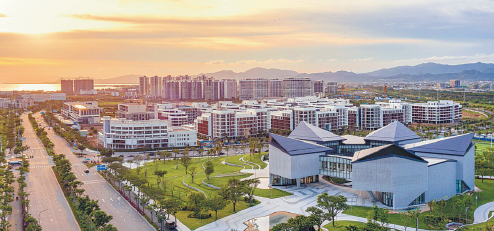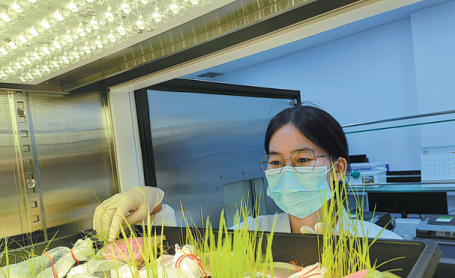Print
By YUAN SHENGGAO | China Daily
Updated:
Science and tech city also expected to lead IP rights for ensuring national food security
Rapid, steady and sustained efforts have gained sound progress in turning the Sanya Yazhou Bay Science and Technology City into a highland for scientific innovation and industrial development in Hainan Free Trade Port.
The Yazhou Bay sci-tech city is situated in western Sanya, China's southernmost trading port city and an important harbor for the ancient Maritime Silk Road. It was established in 2019 as one of the major industrial parks in Hainan Free Trade Port, a benchmark project that is expected to enable the island province to lead the way in China's reform and opening-up in the new era.
Occupying more than 69 square kilometers, the Yazhou Bay sci-tech city is designed by the central government to carry out two strategic national missions-promoting scientific and technological innovation for improved seed varieties, along with independent intellectual property rights to ensure national food security and the development of deep-sea exploration technologies, according to the Yazhou Bay industrial park administration.
Construction of projects launched for Nanfan scientific research on seed breeding has been accelerating at the sci-tech city, in line with the master plan for the construction of Hainan FTP, which covers the entire Hainan island, and the arrangements of the Hainan provincial government.
The Yazhou Bay Seed Laboratory, launched at the sci-tech city in May last year, has built 10 public scientific research platforms, including the large-scale instrument service center, the germplasm resources molecular identification platform, the Nanfan seed industry science and technology innovation center, the bank of core germplasm resources and the artificial climate chamber. They will be equipped with about 7,000 sets of globally advanced facilities, when fully installed in the near future.
Germplasm refers to a collection of genetic resources for an organism. For plants, the germplasm may be stored as a seed collection or, for trees, in a nursery.
Offseason seed breeding in South China's Hainan province, or Nanfan as it is popularly known among Chinese agricultural scientists, started in the 1950s as agricultural scientists came to Sanya, Ledong and Lingshui from November to May to conduct seed breeding-related activities. Shortening the breeding cycle by half or more, Nanfan has accelerated the breeding process and greatly improved the adaptability of seed varieties, experts said.
At the Nanfan breeding bases, some 8,000 scientists and workers from more than 800 research institutions and universities gather from across the country to the vital seed propagation bases each year. More than 70 percent of China's seeds, or over 20,000 new varieties, have been bred through cultivation at Nanfan bases in tropical Hainan, dubbed China's Silicon Valley of Seed Breeding, according to Huang Zhengen. Huang is the chief agronomist at the Hainan Provincial Department of Agriculture and Rural Affairs as well as the head of the provincial Nanfan breeding administration.
Covering more than 240,000 square meters, the Yazhou Bay lab has gathered about 1,100 research staff to work on seed industry innovation, in collaboration with around 20 member institutions, including the Chinese Academy of Sciences, the Chinese Academy of Agricultural Sciences, the Chinese Research Institute of Aquatic Products, Chinese University of Agriculture and China National Seed Group.
Backed by professional technical support teams, comprehensive public service platforms and farming lands as test fields for seed breeding, the lab will function as a powerful innovation engine of the 'Nanfan Silicon Valley' to help cultivate a complete high-level chain that links theoretical innovation with technology integration, seed-breeding design and industrial incubation, and carry out joint innovative research to tackle bottlenecks, according to the sci-tech city administration.
The administration said the lab has completed a pool of projects and that contracts have been signed to jointly tackle 76 seed-breeding technological research projects.
Meanwhile, construction of the first-phase national (Sanya) quarantine inspection and isolation center and the R&D center for non-human primate germplasm resources and models are progressing smoothly. Construction of the international center for corn technology innovation and achievement transformation has been launched, along with trial operation of the biological breeding zone.
A number of featured projects will also be launched to improve the scientific and technological innovation system of the seed industry. They will include the offshore science and technology innovation center for global animal and plant germplasm resources, the national transit and isolation base for crop germplasm resources, the national transfer and transformation center for tropical agricultural scientific and technological achievements, and a demonstration project showcasing technologies and production models for sustainable agricultural development, said officials with the sci-tech city administration.
Six kilometers away from the Yazhou Bay seed lab, the first-phase global transit base for animal and plant germplasm resources will be operational later this year. It will help enrich China's seed resources, improve the nation's seed-breeding technological know-how and boost cooperation in the global seed industry through exchanges and collaborative research, said Ge Ruiming, deputy director of the Yazhou Bay sci-tech city administration.
Thanks to the unique natural conditions and favorable policies for Hainan FTP, the sci-tech city has attracted more than 600 agricultural enterprises. They include leading domestic seed developers such as China National Seed Group Corp, Yuan Long Ping High-Tech Agriculture and Dabeinong Technology Group. Also included are KWS from Germany and KeyGene from the Netherlands.
The Yazhou sci-tech city has adopted the highest international standards to establish a special zone ensuring that seed intellectual property rights resulting from new scientific and technological innovation are well protected and produce industrial benefits as soon as possible, according to the city administration. It said regulatory measures on issues such as identity registration of germplasm resources, gene editing and genetically modified organisms safety as well as the protection of intellectual property rights will be advanced to stimulate market vitality.
Hainan will soon release its ideas for implementing the national plan for construction of Nanfan Silicon Valley (2021-30) and will work to make the island province a national pioneer area for systematic integration and innovation, according to provincial government officials.
The officials said that by focusing on ensuring national food security and upgrading the seed industry, Hainan is building institutional systems. These systems are focused on protecting germplasm resources, guaranteeing breeding bases, scientific and technological innovation in the seed industry, a modern seed industry, seed industry policy system, and seed industry supervision and governance.
Yazhou will also make efforts to pass the capability test of the International Seed Testing Association in four years and become an ISTA member to provide internationally recognized testing services for the import and export of germplasm resources as well as seeds.
The Yazhou Bay sci-tech city has attracted 26 academicians to engage in scientific research and demonstration projects for transformation and application demonstration of sci-tech achievements.
They include academicians Zhu Jiankang, Cao Xiaofeng, Li Song, Jia Chengzao, Yang Shufeng and Fan Yunliu-who have set up six innovation platforms. Another 20 academicians including Li Jiayang, Wan Jianmin, Qian Qian and Bao Zhenmin are preparing innovation teams to focus on cutting-edge theories and bottlenecks in the Nanfan seed breeding and deep-sea fields, according to the industrial park administration.
The launch of the International Federation of Seed Industry Scientists last September marked another move aimed at enhancing cooperation and using the wisdom and resources of global seed industry experts. To date, 138 entities-including national and provincial institutions in China, international seed organizations and the China branches of multinational groups such as Syngenta, Bayer, Limagrain, Corteva Agriscience, KWS and BASF-have joined the federation.
Hainan has designated about 18,000 hectares of land as Nanfan scientific research and breeding reserves, research platforms and other support service areas to accommodate experts and facilities. A prototype for Nanfan Silicon Valley has taken shape in Hainan, said Huang, the Nanfan breeding administration head.


A staff member checks growth of rice seedlings at the Yazhou Bay Seed Laboratory. CHINA DAILY

An aerial view of the Yazhou Bay seed lab. CHINA DAILY
Copyright © Sanya Municipal Government. All rights reserved.
Presented by China Daily.